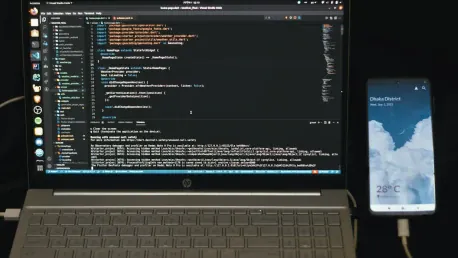Mobile app development is evolving rapidly, driven by advancements in technology and changing user expectations. To keep up with the competition, developers must stay abreast of the latest trends and incorporate them into their apps. This article explores the key trends that are shaping the future of mobile app development and how they can help create more engaging and innovative applications.
AI and Machine Learning
Transformative Power of AI
Artificial intelligence and machine learning are making significant impacts on mobile apps, enhancing their capabilities and user experiences. AI’s ability to process large amounts of data in real-time allows for personalized recommendations and insights, which greatly improve app engagement. For example, an AI-driven health app can analyze user data to provide personalized fitness plans tailored to individual needs and goals. This use of AI technology not only enhances user experience but also fosters higher retention rates.
Moreover, AI-powered chatbots and virtual assistants are becoming increasingly prevalent in mobile apps. These intelligent systems offer real-time customer support, streamline user interactions, and provide instant solutions to user queries. As virtual assistants become more sophisticated, they can handle complex tasks and provide accurate responses, leading to a more seamless user experience. Incorporating AI technology into mobile app development allows developers to create apps that are smarter, more efficient, and responsive to user needs.
Personalization and Real-time Data Analysis
Applications like Netflix and Spotify use AI to deliver personalized content to users, leading to higher user retention. Learning platforms such as Duolingo leverage AI to tailor lessons to individual learning pace, showcasing the powerful role of AI in enhancing user experience. Personalization, driven by AI, is becoming a cornerstone of successful mobile apps, as it helps create an individualized user experience that fosters long-term loyalty.
Additionally, real-time data analysis powered by machine learning algorithms enables apps to make dynamic adjustments based on user behavior and preferences. Financial apps, for instance, can provide personalized investment advice and predict market trends based on real-time data analysis. E-commerce apps can recommend products based on user’s browsing history and previous purchases, enhancing the shopping experience. This capability to process and utilize data in real-time not only helps in retaining users but also opens up new avenues for monetization and growth.
AR/VR Technologies
Enhanced User Engagement
AR and VR are revolutionizing user interaction by creating immersive experiences. These technologies are prevalent in gaming, virtual shopping, and virtual tours, offering unique opportunities for app differentiation. For example, games like Pokémon Go utilize augmented reality to blend digital content with the real world, providing an engaging and interactive gaming experience.
Similarly, retailers can use AR to offer virtual try-ons, allowing customers to see how a product will look without physically trying it on. Virtual room decorators use AR to let users visualize furniture in their space before making a purchase. These applications not only enhance user engagement but also drive higher conversion rates and customer satisfaction. The immersive nature of AR/VR technologies makes them a valuable tool for creating memorable user experiences that encourage long-term app usage.
Investments and Consumer Interest
Major tech companies like Google, Facebook, and Apple are heavily investing in AR/VR, highlighting their potential. Surveys indicate that users are more willing to spend on apps that offer AR experiences, making it a lucrative feature for developers to consider. Google has invested in its Tango project, Facebook owns Oculus, and Apple continues to enhance its ARKit development platform, reflecting the significant market potential of these technologies.
As companies continue to invest in AR/VR, the technology becomes more accessible and integrated into everyday applications. This increased availability encourages developers to adopt AR/VR features in their apps, creating a competitive edge. As consumer interest in immersive experiences grows, the demand for AR/VR-enabled apps is expected to surge, making it essential for developers to stay ahead of the curve and incorporate these technologies in their app development strategies.
IoT Integration
Expanding Connectivity
The Internet of Things (IoT) connects various smart devices, providing a seamless experience across different platforms. By integrating mobile apps with IoT devices such as wearables and smart homes, developers can create more comprehensive user experiences. For instance, fitness apps that sync with smartwatches can track health metrics in real-time, providing users with instant feedback and insights on their physical activity.
Smart home apps integrated with IoT devices can allow users to control home appliances remotely, enhancing convenience and security. For example, a security app linked to smart door locks and cameras enables users to monitor and control home access from their mobile devices. These interconnected experiences not only improve functionality but also create a sense of cohesive and intelligent living environments, enhancing user satisfaction and engagement.
Real-time Data Exchange
Ensuring compatibility with various connectivity options like Wi-Fi, Bluetooth, and 5G enhances the functionality of IoT-integrated apps, enabling real-time data exchange and advanced features. Smart healthcare devices, for instance, can transmit patient data directly to doctors, allowing for prompt medical intervention. This real-time data exchange capability is crucial for applications that rely on timely and accurate information to deliver services effectively.
Furthermore, industrial IoT applications can streamline operations by monitoring equipment performance and predicting maintenance needs. This predictive maintenance capability, powered by real-time data analysis, helps reduce downtime and optimize resource utilization. By leveraging IoT integration, developers can create apps that offer real-time, data-driven interactions, elevating both user experience and operational efficiency.
5G Technology
Superior Speed and Latency
The advent of 5G technology promises enhanced speed and reduced latency, opening new possibilities for app functionalities. Faster download speeds and low latency are crucial for high-definition features and responsive user interactions. For instance, streaming services can deliver ultra-high-definition video content with minimal buffering, providing a seamless viewing experience for users.
The enhanced speed and latency offered by 5G also enable developers to create more sophisticated applications, such as real-time multiplayer games and augmented reality experiences. These apps require stable and fast connections to ensure smooth performance and user satisfaction. With 5G, developers can push the boundaries of what’s possible in mobile app development, delivering faster and more reliable user experiences that meet the demands of an increasingly connected world.
Impact on Real-time Collaboration
5G’s capabilities significantly improve real-time collaboration and interactivity in AR, VR, and IoT applications, providing smoother and more immersive experiences without the lag. This is particularly important for applications that require real-time data processing and immediate response. For example, telemedicine apps can facilitate high-quality video consultations between doctors and patients, ensuring timely and effective medical care.
Similarly, remote work applications that utilize 5G can enhance productivity by enabling real-time collaboration on documents and projects. The low latency ensures that team members can communicate and share information seamlessly, regardless of their location. The integration of 5G technology in mobile apps not only improves performance but also broadens the scope of what can be achieved, offering developers new opportunities to innovate and enhance user experiences.
Cross-Platform Support
Streamlined Development
Modern frameworks like Flutter and React Native allow developers to write a single codebase for multiple platforms. This approach simplifies the development process, saving time, effort, and resources while expanding an app’s reach to both Android and iOS users. By using these frameworks, developers can maintain consistency in app performance and design across different devices, ensuring a smooth and unified user experience.
For example, React Native, developed by Facebook, allows developers to build applications that run on both mobile and web platforms from the same codebase. This approach not only reduces development costs but also speeds up the time-to-market. Flutter, another popular framework by Google, is known for its high-performance capabilities and rich set of customizable widgets. Both frameworks have gained traction among developers for their efficiency and versatility, making cross-platform support a valuable strategy in mobile app development.
Native Device Features
Using frameworks like Flutter and React Native enables apps to utilize native device features, ensuring better performance and user experience across different platforms. These frameworks provide access to native APIs and components, allowing developers to create apps that feel and function like native applications. For example, an app built with React Native can seamlessly integrate with a device’s camera, GPS, and other hardware features, offering a more immersive and responsive user experience.
In addition, cross-platform frameworks come with robust libraries and tools that enhance development capabilities. For instance, Flutter’s Hot Reload feature allows developers to see changes in real-time, speeding up the debugging and testing process. By leveraging the strengths of cross-platform frameworks, developers can build high-quality apps that deliver consistent performance and functionality across various devices and operating systems, expanding their user base and market reach.
Low Code/No Code Technologies
Accelerated Development
Low-code and no-code platforms are transforming app development by enabling rapid prototyping and deployment. These technologies reduce the complexity and cost, making it easier for developers and non-developers to create and test apps quickly. For example, a business owner with limited coding knowledge can use a low-code platform to build a functional e-commerce app, complete with payment gateways and inventory management, in a matter of days.
The ability to create minimum viable products (MVPs) swiftly allows businesses to test market responses and iterate based on user feedback, minimizing risks and maximizing efficiency. Low-code/no-code platforms come with predefined modules and templates that simplify development, making it accessible to a broader audience. This democratization of app development fosters innovation and allows for the testing of diverse ideas without significant financial or technical barriers.
Democratization of App Development
By empowering non-developers to build minimum viable products (MVPs), low-code/no-code platforms are democratizing app development, allowing more innovative ideas to come to fruition with less investment. This shift not only accelerates the development process but also encourages a culture of experimentation and creativity. Small businesses and startups can leverage these platforms to develop customized solutions tailored to their specific needs without relying on extensive technical expertise or resources.
Additionally, low-code/no-code platforms integrate seamlessly with other enterprise systems and technologies, enabling businesses to create end-to-end solutions that improve operational efficiency. The scalability and flexibility of these platforms make them suitable for a wide range of applications, from simple tools to complex enterprise-grade software. By lowering the barrier to entry, low-code/no-code technologies are opening new opportunities for digital transformation and fostering a more inclusive and dynamic app development landscape.
Innovative Mobile App Strategies for the Future
The rapid evolution of mobile app development is spurred by technological progress and shifting user demands. As the industry continues to grow, developers need to stay updated on the latest trends to remain competitive. This means integrating cutting-edge technologies and innovative features into their applications. This article delves into the crucial trends shaping the future of mobile app development, examining how these trends can lead to the creation of more engaging, user-friendly, and innovative apps.
Advancements such as artificial intelligence (AI), machine learning (ML), and augmented reality (AR) are transforming the mobile app landscape. AI and ML provide personalized experiences and smarter applications, while AR enhances user interaction by blending digital elements with the real world. Additionally, the rise of 5G technology promises faster, more reliable connectivity, enabling more complex and sophisticated app functionalities. Developers who leverage these emerging trends can ensure their mobile applications meet modern user expectations and stand out in an increasingly crowded market.









